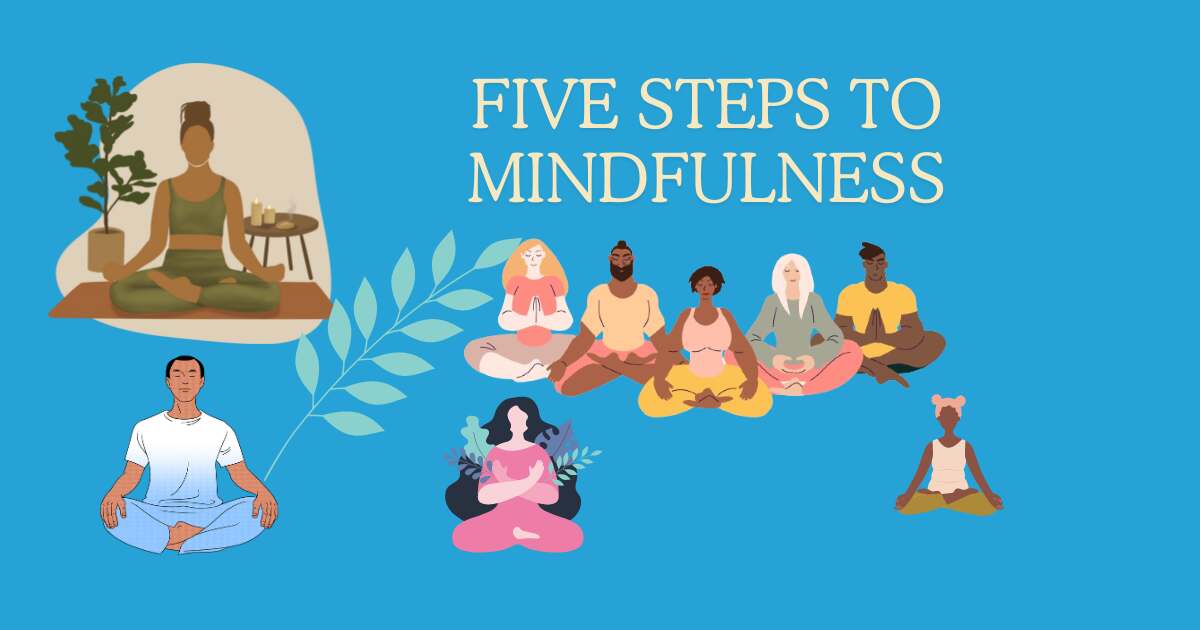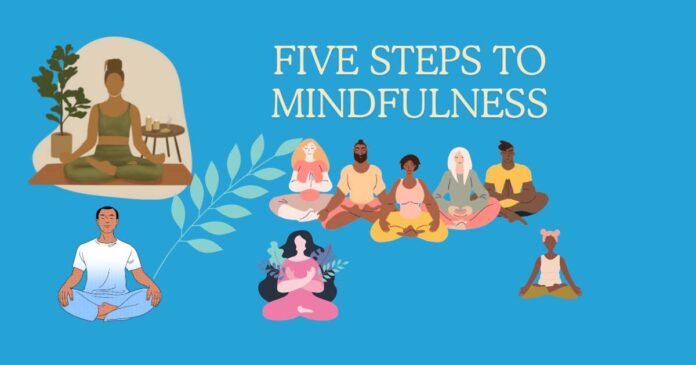In the hustle and bustle of modern life, finding moments of peace can seem like an elusive goal. However, adopting mindfulness can be very important in unlocking a sense of peace and clarity amidst the chaos. Today, let us try to learn five important practical steps to include mindfulness in your daily routine.

I. Introduction
A. Definition of Mindfulness
Mindfulness is the practice of bringing one’s attention to the present moment, fostering an awareness of thoughts, feelings, and sensations without judgment.
B. Importance of Mindfulness in Daily Life
In today’s fast-paced world, the significance of mindfulness extends beyond stress reduction. It enhances overall well-being, improves focus, and promotes a positive outlook on life.
II. Step 1: Understanding the Basics
A. What is mindfulness meditation?
Mindfulness meditation is a foundational practice that involves cultivating awareness through focused attention, often centered on the breath.
Mindfulness is something we all haven’t ability to be fully aware of where we are and what we’re doing without getting too stressed. You don’t need to do anything special to have it; you just need to learn how to use it.
Different Ways to Practice Mindfulness
While mindfulness is natural, you can get better at it with some techniques. For example:
- Sitting, walking, standing, or moving meditation (even lying down, but be careful not to fall asleep).
- Taking short breaks during your day.
- Combining mindfulness with other things like yoga or sports.
Why Mindfulness is Good for You
When we practice mindfulness, it’s not about focusing on the benefits but doing the practice itself. Still, there are some good things that come out of it. Mindfulness helps reduce stress, improves how well we do things, gives us insights into our minds, and makes us pay more attention to others.
Interesting Facts About Mindfulness
- Mindfulness is not strange or unknown; it’s something we already do.
- It’s not an extra thing we have to do; we already have the ability to be present.
- You don’t have to change who you are. Mindfulness recognizes and enhances the good things about us.
- Anyone can do it. It doesn’t require changing your beliefs, and it’s easy to learn.
- It’s not just a practice; it brings awareness and caring into everything we do.
- Science shows that mindfulness is good for our health, happiness, work, and relationships.
- It can help us deal with a complicated world and find solutions to tough problems.
B. Connecting Mind and Body
Establishing a connection between the mind and body is crucial to mindfulness. Recognizing bodily sensations and their connection to emotions forms the basis of this practice.
III. Step 2: Incorporating Mindful Breathing
A. Benefits of Mindful Breathing
Mindful breathing not only promotes relaxation but also improves concentration and reduces anxiety. Understanding its benefits is key to incorporating it into your routine.
B. Techniques for Effective Mindful Breathing
Explore various breathing techniques, such as diaphragmatic breathing and box breathing, to discover what works best for you.
IV. Step 3:Observing thoughts without judgment
A. The Concept of Non-Judgmental Awareness
Mindfulness involves observing thoughts without judgment. This non-judgmental awareness permits a clearer understanding of one’s mental processes.
B. Practical Tips for Observing Thoughts
Apply practical tips to develop a non-judgmental mindset, such as accepting thoughts without paying attention to them.
V. Step 4: Cultivating Mindful Awareness in Daily Activities
A. Mindful Eating
Savoring each bite, focusing on flavor and texture, turns a mundane activity like eating into a conscious experience.
B. Mindful Walking
Try turning your daily walk into a mindful practice by focusing on each step, feeling the ground beneath your feet, and appreciating the rhythm of your walk.
VI. Step 5: Creating a Consistent Mindfulness Practice
A. Setting realistic goals
Establish achievable mindfulness goals to gradually build a consistent practice.
B. Overcoming Challenges in Maintaining Consistency
Recognize and address common challenges in maintaining mindfulness while ensuring flexible and consistent practice.
VII. Mindfulness and its stress reduction
A. Impact of Mindfulness on Stress Levels
Scientific studies highlight the positive effects of mindfulness in reducing stress levels, making it a valuable tool in stress management.
B. Scientific Studies Supporting Mindfulness for Stress Reduction
You should explore research findings that support the effectiveness of mindfulness in greatly reducing the physical and psychological effects of your stress.
VIII. Mindfulness in the Digital Age
A. The Role of Mindfulness in Reducing Digital Overwhelm
We are currently living in an age dominated by technology, and mindfulness acts as a very powerful antidote to digital pressure and information saturation.
B. Practical Tips for Mindful Technology Use
Learn practical strategies for incorporating mindfulness into your digital habits, promoting a healthy relationship with technology.
IX. Mindfulness and Improved Mental Health
A. Connection Between Mindfulness and Mental Well-Being
We must explore how mindfulness complements traditional mental health practices, contributing to good emotional resilience and overall mental health.
B. Mindfulness as a Complementary Practice to Mental Health Treatment
Explore the integration of mindfulness into therapeutic approaches and its role in supporting individuals with mental health challenges.
X. Mindfulness in the Workplace
A. Benefits of Mindfulness for Employees and Employers
Businesses are recognizing the positive impact of mindfulness on employee well-being, productivity, and workplace culture.
B. Simple Mindfulness Exercises for the Workplace
Explore easy-to-implement mindfulness exercises that can be seamlessly incorporated into the workday.
XI. Cultivating Mindfulness in Relationships
A. Enhancing Communication through Mindfulness
Mindfulness enhances interpersonal relationships by fostering active listening and promoting genuine understanding.
B. Nurturing Empathy and Understanding
Developing empathy through mindfulness creates stronger connections and cultivates a more compassionate approach to relationships.
XII. Mindfulness for Personal Growth
A. Reflecting on Personal Goals
Mindfulness provides a valuable tool for self-reflection, aiding in the clarification of personal goals and aspirations.
B. Integrating mindfulness into goal-setting
Learn how to integrate mindfulness into the process of setting and achieving personal and professional goals.
XIII. Mindfulness and Improved Sleep
A. The Connection Between Mindfulness and Quality Sleep
Explore the relationship between mindfulness and improved sleep quality, offering practical tips for a restful night.
B. Mindful Practices for Better Sleep
Incorporate mindfulness practices into your pre-sleep routine to enhance relaxation and promote better sleep.
Mindfulness and meditation can potentially help people sleep in many different ways.
Slow breathing: Deep breathing using the diaphragm, a muscle at the bottom of the lungs, is a cornerstone of many meditation practices. Focusing on calm, deep breathing appears to be one of the major pathways by which meditation reduces our anxiety.
Calming stress pathways: Like other relaxation techniques, meditation can help us greatly reduce our heart rate and blood pressure. Some data suggests that meditation reduces the activation of stress pathways in the brain as well as our stress hormone levels.
A better mental outlook: Focusing on the present moment while meditating can help a person think less anxiously about the past or future and work through their reactions to difficult experiences.
Better pain management: Some studies have shown that meditating can reduce our pain, while others have not. Even when meditation does not reduce a person’s physical pain, it can still help us greatly in reducing or making the pain much less or more bearable. This effect can be very useful for people who have a lot of trouble sleeping due to chronic pain.
XIV. Mindfulness Apps and Resources
A. Review of Popular Mindfulness Apps
Discover a curated list of popular mindfulness apps that cater to various preferences and needs.
- Guided Meditation Apps: Apps that provide audio guidance for meditation sessions, helping users focus and relax.
- Mindfulness Timer Apps: Timer-based apps that assist in setting specific durations for meditation or mindfulness practices.
- Breathing Exercise Apps: Apps offering guided breathing exercises to promote relaxation and stress reduction.
- Daily Mindfulness Reminder Apps: apps that send daily reminders to practice mindfulness, fostering consistency.
- Mindful Journaling Apps: Apps allowing users to journal their thoughts, feelings, and experiences, promoting self-reflection.
- Sleep Meditation Apps: Apps designed to aid relaxation and mindfulness practices specifically tailored for better sleep.
- Mindful Movement Apps: apps incorporating mindfulness into physical activities like yoga or stretching exercises.
- Gratitude Apps: Apps encouraging users to cultivate a grateful mindset through daily gratitude practices.
- Mindfulness Games Apps: Apps that ramify mindfulness practices, making the experience engaging and enjoyable.
- Stress Reduction Apps: These apps focus on providing tools and techniques for managing and reducing stress levels.
- Mindfulness Podcast Apps: Apps featuring podcasts discussing mindfulness topics and offering insights and tips.
- Mindfulness Community Apps: Apps connecting users with a community of individuals practicing mindfulness, fostering a sense of support and encouragement.
- Nature Sounds Meditation Apps: Apps incorporating sounds of nature to enhance mindfulness and create a calming environment.
- Mindfulness Courses Apps: Apps offering structured courses on mindfulness, suitable for both beginners and experienced practitioners.
- Mindfulness for Kids Apps: Apps specifically designed to introduce mindfulness to children through interactive and age-appropriate activities.
Remember to explore various apps to find the one that aligns with your preferences and goals for practicing mindfulness.
B. Online Resources for Mindfulness Practices
Explore online platforms offering a wealth of resources, from guided meditations to informative articles, to support your mindfulness journey.
XV. Conclusion of the Five Steps to Mindfulness
A. Recap of the Five Steps to Mindfulness
Summarize the key takeaways from the article, emphasizing the simplicity and accessibility of incorporating mindfulness into daily life.
B. Encouragement for Readers to Begin Their Mindfulness Journey
Inspire readers to embark on their mindfulness journey, assuring them that small, consistent steps can lead to profound positive changes.
FAQs: Unlocking the Path to Mindfulness
Is mindfulness only about meditation?
- No, mindfulness encompasses various practices, including meditation, but also extends to daily activities and thought awareness.
How long does it take to experience the benefits of mindfulness?
- The timeline varies for each individual, but consistent practice often yields noticeable benefits within a few weeks.
Is mindfulness a religious practice?
- While mindfulness has roots in contemplative traditions, it can be practiced in a secular manner, making it accessible to individuals of all beliefs.





Somebody essentially lend a hand to make significantly posts I might state That is the very first time I frequented your web page and up to now I surprised with the research you made to create this particular put up amazing Excellent job
Thanks my dear friend, I have a request to you that can you put the URL of my website on your website for better ranking, I will also put the URL of your website in my website. I will wait for your comment. Thanks